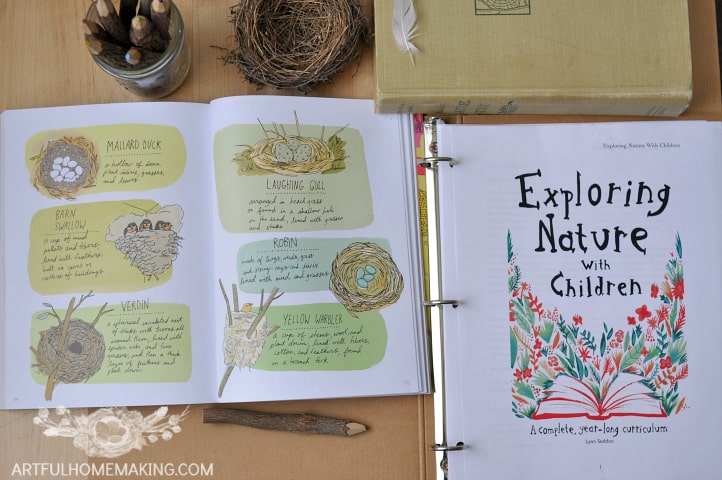Charlotte Mason Nature Study
One of my favorite things about the Charlotte Mason method of homeschooling is the emphasis on nature study.
With these simple Charlotte Mason nature study tips, you’ll find that it’s an easy and enjoyable tradition to add to your school days.

When my children were younger, we lived on 10 acres, surrounded by a cow pasture on one side, and horses on the other. We had a large garden, and a big circular driveway where the kids loved to ride bikes and tricycles.
Naturally, we spent a lot of time outdoors. And we had The Handbook of Nature Study, A Charlotte Mason Companion, and lots of field guides for help and inspiration.
We had an ant farm, and a butterfly garden.
We went berry picking, apple picking, and pumpkin picking.
Our favorite picnic location was a beautiful state park, where we were able to feed the fish, go on a hike up some beautiful stone steps, and across a wooden bridge, and finish with a fire to make s’mores.
In short, we were surrounded by nature, and we spent a lot of time talking about it, observing it, and enjoying it.
Perhaps a mother’s first duty to her children is to secure for them a quiet growing time … the waking part of it spent for the most part out in the fresh air. ~Charlotte Mason
After we moved away from that rental house, we found other ways to enjoy nature.
The key is that no matter where you are, you can find some piece of God’s creation to study and observe and from which to learn.
It doesn’t matter if it’s a local park, a nearby field, or in your own backyard. Nature is everywhere around us!
Charlotte Mason Nature Study
It is infinitely well worth the mother’s while to take some pains every day to secure, in the first place, that her children spend hours daily amongst rural and natural objects; and, in the second place, to infuse into them, or rather, to cherish in them, the love of investigation. ~Charlotte Mason
I have always loved Charlotte’s emphasis on nature study. I’ve never questioned the benefits (to both children and their mothers) of spending much time out in the fresh air, observing and reveling in nature.
The question isn’t “Why should we do this?” Rather, the question most busy homeschool moms often ask is, “How?”
How can we fit one more thing into our busy homeschool days?
If we’re feeling like nature study is just one more thing, and that it’s too hard, then we are probably overcomplicating things.
Don’t overthink it. It’s really pretty simple!
We made a video to go with this post! You can view it below, or click here.
3 Simple Steps
I’ve come up with a few simple steps for getting started with Charlotte Mason nature study, if this is all new to you.

First, gather a few supplies.
Your nature study supplies don’t need to be expensive or elaborate. Here are a few of our favorite supplies:
- Artist’s Sketchbook or a binder with drawing paper or cardstock
- Colored Pencils (we love Prismacolor and these for younger children)
- Field Guides
- Handbook of Nature Study
- Small Pocket Microscope
- Bug Cage
Next, go outside together.
Get outside and explore nature! Take your sketchbook or a camera to record what you see.
Immerse yourself in the fresh air, green grass, colorful leaves, rain, or snow.
Regardless of the weather, there’s something interesting or beautiful to observe.

Record your findings.
You can either sit outside and draw what you see, or you can bring the specimen inside to observe it and draw it.
And keep in mind that you don’t always have to record everything.
There can be times when you just go outside and enjoy your findings without making an entry into your nature journal. This is perfectly acceptable and still beneficial!

Some children are resistant to keeping a nature journal. In this case, I don’t push it, but occasionally I’ll suggest they make an entry.
For children who don’t enjoy drawing (or who find it difficult), I’ve found it helpful to give them a simple drawing book to give them an idea to get them started.
Here are a few books that have helped us:
- Keeping a Nature Journal
- The Law’s Guide to Nature Drawing and Journaling
- The Wonders of Nature Sketchbook
- Drawing Trees
- Drawing Wildlife
- Nature Anatomy
Another thing to remember is that nature journals are personal, and they aren’t something to be “graded.” Don’t critique their artwork, either.
I find it’s best to offer resources that might be helpful (such as one of the above books), and then let them record it however they’d like.
For instance, if we’ve been observing a mushroom, I might open The Law’s Guide to page 246, Drawing Mushrooms. Or the following pages, Mushrooms Step by Step. That way, we all have a guide to go by if we need or want one.
Exploring Nature with Children

If you’re new to nature study, or you just want something already put together for you, I highly recommend Exploring Nature with Children.
This is a complete, year-long Charlotte Mason nature study curriculum written by Lynn Seddon. You get 48 weeks of nature study organized by season.
Each week’s nature study contains the following:
- A themed nature walk
- References to the Handbook of Nature Study
- A themed book list
- A poem related to the nature theme of the week
- A piece of art that relates to the nature theme
- Extension activities
Lynn has also come out with Exploring Nature with Children: A Guided Journal, to enhance your Exploring Nature with Children studies (choose either print or cursive for your journal).
This is a companion journal that goes with the main Exploring Nature with Children book mentioned above.

The guided journal includes poetry copy work, a calendar of firsts, and several other printables to go with your weekly nature study.
We’re going to be using Exploring Nature with Children this year for most of our nature study, and we’re starting this week with the August Summer Pond Study.
Our neighbor has allowed us to use his pond (which is in the woods behind our house), and we’re so excited to have a nearby pond to study!
Is Charlotte Mason nature study something you include in your homeschool? I’d love to hear about it!
Related Posts:
Disclosure: This post contains affiliate links. Read my full disclosure here.




We try to head out hiking at least once or twice a week and my boys often take off during the school day to the woods that border our house; they’ve learned to come get me if they find something truly special or unique (like the hawk we found eating a duck! or the frozen salamander).
Wow! What amazing nature discoveries!
Hello,
I am trying to understand the CM approach better but I am finding conflicting tips. Maybe you can help me. It seems with Nature notebooking the idea is for the kids to go outside and observe and write in their notebook. Yet- I keep seeing people using things like The Handbook of nature study. How? Why? Not seeing how it fits in with the open-ended-ness I thought CM was wanting?
Hi Pam! Most people use The Handbook of Nature Study as a way to enrich nature study, or as a reference book when the kids have questions, or when you want to dig deeper into a certain topic. It’s not required, it’s just a helpful resource if you’d like to use it. We have used it both ways, sometimes as a guide and also as a reference book to learn more about a particular aspect of nature. Hope that helps!
For what ages would you say this guide is appropriate?
This guide has lots of ideas that would be useful for younger children, but it’s also useful for older children as well. For instance, there are picture book suggestions, but you can expand the ideas to include older kids also. I currently use this with elementary through junior high levels.
Thank you, Joy! That was helpful :).
You’re welcome!
I’m thinking about using this for a homeschool co-op for a themed year of outdoor nature discovery. Do you have any thoughts on how I could extend this through to high school students?
Hi Kristen! So much of the main information in the guide is useful and appropriate for any age (it’s not written in a way that makes it seem like it’s just for little kids). There are suggestions for picture books, but you could eliminate those for high school students and instead include more technical nature books and field guides. High school students could also be encouraged to keep a more detailed and technical nature notebook if they find that interesting. Those are just a few ideas. Hope that helps!
Bought the download and can’t wait to do this with our kids this year! Thanks for the suggestion!
Yay! I hope you love it as much as we do! 🙂
Dear Joy,
As the idea of homeschooling/Charlotte Mason is still relatively new to me, I am still in the process of learning and gathering information. However I very much like the idea of integrating nature study in the school curriculum.
My eight year old stepson suffers from ADHD and my husband and I have discovered, that spending time outside/in nature helps to calm him down and bring his “constantly running mind” to rest.
I have not yet put any ideas into action, but my idea is to follow nature through the year, looking at a specific topic each month. For example, in September, I would take a look at questions such as “what are the characteristics of autumn”, “why do leaves change their color” and which are typical trees in our area, “which animals start preparing for winter” and take a detailed look at those animals.
I have bought a book for children which outlines the “walk of nature” throughout the year. However, I am missing somewhat the linkage to our Christian traditions so that I will need to complement the walk of nature with our Christian beliefs. I have not yet finished this process but I hope I will with the beginning of the new school year in September.
Kind regards,
Carmen
Hello Carmen!
Your idea to follow nature through the year focusing on a different topic each month sounds great! I’m sure your efforts will be such a blessing to your son. Being out in nature is very calming and inspiring (even to us as moms!). 🙂
Getting children out and about and interested in nature is great. The traditional classroom environment is certainly far too stuffy. I never home-schooled my kids but I did think about it